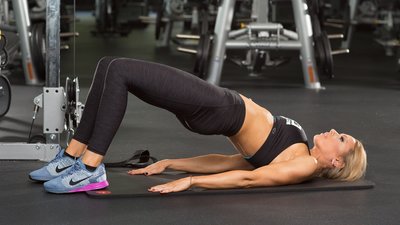Many people train their glutes solely for aesthetic reasons. But an increasing number of women realize that the curve is just gravy. The meat and potatoes of the argument, as I explain in my article "7 Glute Training Mistakes Holding Back Your Backside," is that strong, highly functioning glutes are integral to the overall health of the human body and its ability to perform at a high level.
Squat and deadlift variations have their place in the quest for backside strength, but they definitely aren't where the story has to end. This is one muscle group that can benefit from some direct work across a number of rep ranges, from heavy barbell work to higher-rep band-resisted work that will burn like crazy.
Here are eight of my favorite glute exercises that will help you build your ultimate backside.
1. Barbell Glute Bridge With Band Abduction
Kick up your butt-building barbell glute bridges by adding in band-resisted hip abductions. While a little elastic loop might seem like a minor addition, it makes a huge difference by honing in on the ever important, but often neglected, gluteus medius muscle. This simple addition will also make your glutes burn more than you can possibly imagine.
Directions
- Get into the glute bridge starting position. Put a low-to-medium resistance band just above your knees, and rest a barbell in your hip crease.
- Keep your shins in a relatively vertical position to prevent your hamstrings from taking over.
- Lift your hips by pressing through the middle and back of your feet, and squeezing your glutes. Be careful not to hyperextend your lower back or flare your ribcage. Keep your core muscles braced for the duration of the exercise.
- When you are in the top position, your body should form a straight line from your knees to your shoulders. From this position, perform 2-3 hip abductions (pushing your legs out, then bringing them back). Then return to the starting position. This is one rep. Reset, and repeat.
- Perform 3-5 sets of 5-10 reps. This does not include your warm-up set.
2. Single-Leg Barbell Hip Lift With Foot on Wall
This innovative single-leg hip lift will build your backside and develop your hamstrings at the same time. Unlike a regular hip lift, where you drive your foot directly down into the ground, you will drive your foot horizontally into a wall. You will be surprised at just how challenging and effective this simple tweak is. Make sure you perform this movement by engaging your glutes and hamstrings, and not by hyperextending your lower back and flaring your ribcage.
Directions
- Maintain a neutral spine alignment as you rest one foot on a wall and lift the other. The barbell should be resting in your hip crease.
- As you bring your hips up, pause for a count at the top.
- Lower with control to increase the time that your glutes are under tension. Make sure that you engage your glutes and core on the non-working side to keep your hips level.
- Perform 3-4 sets of 8-15 reps per leg. This does not include your warm-up set.
3. Negative One-and-a-Half-Rep Rear-Foot-Elevated Split Squat
This split squat variation will hit your glutes more than most exercises. While regular rear-foot-elevated split squats are tough enough, performing them as one-and-a-half reps will light your backside on fire.
Go as low as you can while keeping your spine in a healthy alignment. Your front leg should be doing as close to 100 percent of the work as possible, so make sure that your body travels in a vertical path. Do not allow your hips to travel backward toward your non-working leg. Keep your core braced for the duration of the exercise.
Directions
- Perform a split squat, taking 3 seconds to lower down. Then, stand halfway up, lower back down, and stand back up. This is one rep.
- You can up the ante even more by looping a resistance band under the middle of your foot and resting it on your upper traps. This will force your glutes to work even harder, particularly during the lockout and the initial part of the eccentric phase.
- Perform 3-4 sets of 5-10 reps per leg. This does not include your warm-up set.
4. Landmine Deadlift With Band Resistance
Many people think that unless you deadlift a barbell from the floor, it's a total waste of time and doesn't count. I disagree. To strengthen and build your backside, there is absolutely no rule that you must deadlift in one particular way.
This fantastic exercise is much less technical than most deadlift variations. It will allow people of most fitness levels and abilities to strengthen and develop their glutes, master the ever-important hip hinge, and perhaps build the strength and technical ability to train more advanced deadlift variations.
Directions
- Keep the bar tight to your body throughout the movement. Do not allow it, and your arms, to drift forward.
- Lower your body down by hinging your hips back as far as you can. Don't round your back, drop your chest, or squat down.
- When you feel a slight stretch in your hamstrings, return to the starting position by driving through the middle and back of your feet, and squeezing your hamstrings and glutes. Keep your core muscles braced for the duration of the exercise, and maintain a neutral spinal alignment. Do not allow your lower back to hyperextend or round, or your ribcage to flare. If you are doing this properly, will you feel your hamstrings and glutes working right from the start!
- Perform 3-4 sets of 8-12 reps. This does not include your warm-up set.
5. Banded Side Plank Hip Abduction With Bottoms-Up Kettlebell Hold
It's a mouthful, I know! But this brutally challenging movement also provides plenty of bang for the buck. It's a serious core-stability exercise that also strengthens the muscles of the glutes and develops shoulder stability. When you are performing this unique exercise, your core muscles must work big-time to prevent your spine from overextending, rotating, or flexing laterally, and your glutes must work to stabilize your pelvis and abduct the leg.
As with most planks, mindlessly holding for time is not good enough here. You need to contract all your core muscles as hard as you can. Adding in the bottoms-up hold will up the ante even more by forcing the core muscles to work harder, and help improve shoulder stability.
Make sure your spine remains in neutral alignment, your chin remains tucked, your head, ribs, and hips remain stacked, and your shoulders remain packed. I won't lie, this exercise is no joke.
Directions
- Loop a mini band around your legs just above the knee. Then get into a side-plank position with your feet stacked and bottom-side palm facing down.
- Hold a kettlebell bottoms-up by the handle, squeezing the handle to balance it in your hand. Go light here! Then press it above your side using your upper arm.
- Raise your body up into a side-plank position, so that your body forms a straight line. Then abduct your hips by raising your top leg as far as the band allows.
- Perform 3-4 sets of 6-15 abductions per side. This does not include your warm-up set.
6. Double-Band Squat-Stance Cable Walks
This exercise strengthens the muscles of the glutes, but also the quads, hamstrings, anterior core, upper back, lower legs, and even your feet. To make sure your glutes rue the day you did this move, you'll add an extra mini band to the equation.
Unlike most exercises where your weight is on the middle and back portion of your feet, in this exercise, your weight should be predominantly on your forefoot. Make sure you keep all of your toes down, particularly your big and baby toes.
Directions
- Place one resistance band above your knees and one mid-shin height (or around your ankles). Get into a partial squat stance where your thighs are approximately parallel to the ground.
- Grab the cable attachment or band, row it in towards your body, and hold it in that position. Lightly press your knees out against the bands. When you do this, you should feel your gluteus medius (up near your hips) kick in.
- While remaining in the squat stance, walk backward for about 4-5 steps per leg. Then walk forward, with complete control, to the starting position. By now, your quads and glutes should be burning.
- Remain in a squat stance for the duration of the exercise. Do not stand up or tip forward, allow your spine to rotate, or allow your knees to cave in or turn out. Keep your head, torso, and hips stacked.
- One rep is 4-5 steps per leg. Perform 3-4 sets of 4-8 reps. This does not include your warm-up set.
7. Skater Squats
The skater squat (a unilateral squatting exercise) strengthens the muscles in the lower body, but especially the glutes and quadriceps. If you are performing this exercise correctly—which requires a significant amount of strength, stability, and controlled mobility—your glutes will be on fire.
Start out with just body weight. Once you have your form dialed in, you can add weight resistance. You can increase the difficulty even more by performing a goblet-style skater squat where you keep the weight flush against your body instead of holding the weight ahead to create the counterbalance.
Directions
- Squat with your working leg, while your non-working leg floats behind you. You can keep your non-working leg bent at a right angle, or you can keep the leg in a more lengthened position. Whatever option you choose, go as low as you can while maintaining proper form.
- Your non-working knee can touch the ground at the bottom, but don't brace against your foot. This isn't a lunge! To make it less difficult, reduce the range of motion by lowering your knee to a low box or mat.
- Once you reach your full depth, stand up and return to the top position. Keep your core braced for the duration of the exercise. You can create a counterbalance by holding your arms ahead of you, or holding a light weight.
- Perform 3-4 sets of 5-10 reps per leg. This does not include your warm-up set.
8. Double-Banded Seated Glute Abductions
This deceptively tough band-resisted exercise can work at the beginning of your workout as part of your warm-up, at the end of a lower-body workout as a glute finisher, or throughout an upper-body workout as a form of active rest.
Directions
- Place one resistance band just above your knees, and the other at mid-shin height (or around your ankles).
- Sit on a bench or box. Keeping your ribcage down, spine in neutral alignment, core lightly braced, and legs soft, use your glutes to open your legs and control them as they come back together. Keep tension in the bands the entire time so that your glutes are performing the bulk of the work. People often compensate for weak glutes by using their quads, hamstrings, or other muscles to perform the movement.
- Play around with your torso position and figure out what allows you to feel your glutes the most. Some people find that leaning slightly forward works best, and others prefer to adopt more of an upright posture. If you are doing this exercise properly, you will feel it in the upper, outer part of your glutes, as well as in your larger glute muscles.
- Perform 3 sets of 15-25 reps per leg to failure.



